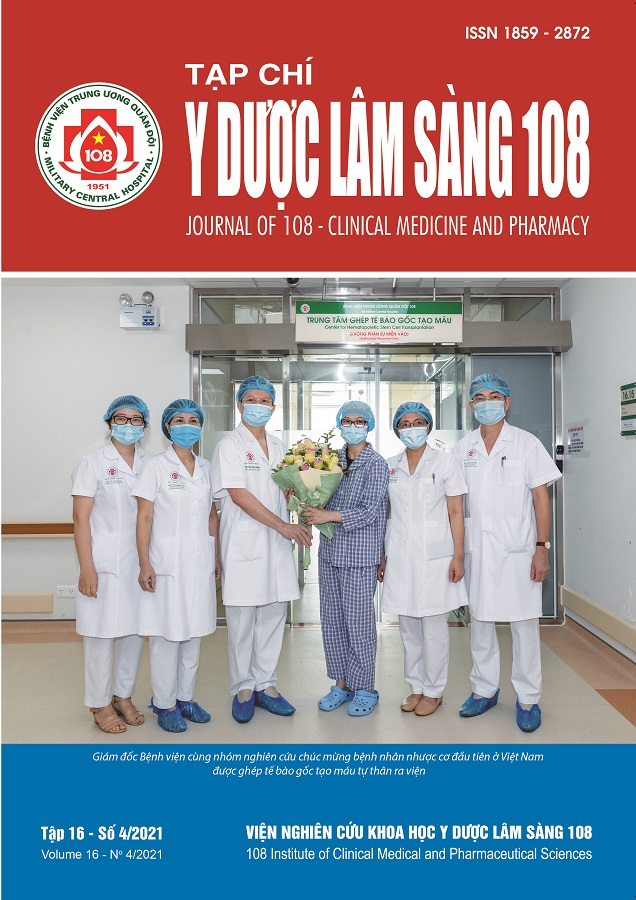Vai trò cắt lớp vi tính đa dãy hệ tĩnh mạch cửa trong lựa chọn và lập kế hoạch can thiệp tạo shunt cửa - chủ trong gan qua đường tĩnh mạch cảnh ở bệnh nhân xơ gan
Main Article Content
Keywords
Tóm tắt
Mục tiêu: Đánh giá vai trò của cắt lớp vi tính đa dãy hệ tĩnh mạch cửa trong lựa chọn và lập kế hoạch can thiệp TIPS ở bệnh nhân xơ gan. Đối tượng và phương pháp: 71 bệnh nhân được chẩn đoán xơ gan có chỉ định can thiệp TIPS được chụp cắt lớp vi tính đa dãy, điều trị tại Bệnh viện Trung ương Quân đội 108 và Bệnh viện Đa khoa tỉnh Phú Thọ từ tháng 10/2013 đến tháng 07/2020. Kết quả: Tỷ lệ bệnh nhân được can thiệp TIPS sau khi chụp cắt lớp vi tính là 70,4%. Nguyên nhân không can thiệp chủ yếu là do bất thường hình thái gan và tĩnh mạch cửa chiếm 38,1% (8/21). Kế hoạch can thiệp từ tĩnh mạch gan phải - nhánh phải tĩnh mạch cửa chiếm 92%, trên thực tế là 70%. Số lần chọc kim vào tĩnh mạch cửa trung bình là 2,0 ± 0,9 lần, chọc kim 2 lần chiếm tỷ lệ cao nhất là 45,8%. Tai biến tụ máu dưới bao gan chiếm tỷ lệ cao nhất là 22,9%. Kết luận: Cắt lớp vi tính có vai trò trong lựa chọn và lập kế hoạch can thiệp TIPS ở bệnh nhân xơ gan
Article Details
Các tài liệu tham khảo
2. Chen YI, Ghali P (2012) Prevention and management of gastroesophageal varices in cirrhosis. Int J Hepatol 2012: 750150.
3. de Franchis R (2015) Expanding consensus in portal hypertension: Report of the Baveno VI Consensus Workshop: Stratifying risk and individualizing care for portal hypertension. J Hepatol 63(3): 743-752.
4. Lee EW et al (2014) Coil-assisted retrograde transvenous obliteration (carto) for the treatment of portal hypertensive variceal bleeding: Preliminary results. Clin Transl Gastroenterol 5: 61.
5. Loffroy R et al (2015) Transjugular intrahepatic portosystemic shunt for acute variceal gastrointestinal bleeding: Indications, techniques and outcomes. Diagn Interv Imaging 96(7-8): 745-755.
6. Meine TC et al (2020) Transjugular intrahepatic portosystemic shunt placement: Portal vein puncture guided by 3D/2D image registration of contrast-enhanced multi-detector computed tomography and fluoroscopy. Abdom Radiol (NY).
7. Punamiya SJ, Amarapurkar DN (2011) Role of TIPS in improving survival of patients with decompensated liver disease. Int J Hepatol: 398291.
8. Qin JP et al (2015) Contrast enhanced computed tomography and reconstruction of hepatic vascular system for transjugular intrahepatic portal systemic shunt puncture path planning. World J Gastroenterol 21(32): 9623-9629.
9. Rodrigues SG et al (2019) Systematic review with meta-analysis: portal vein recanalisation and transjugular intrahepatic portosystemic shunt for portal vein thrombosis. Aliment Pharmacol Ther 49(1): 20-30.
10. Senzolo M et al (2006) Transjugular intrahepatic portosystemic shunt for portal vein thrombosis with and without cavernous transformation. Aliment Pharmacol Ther 23(6): 767-775.
 ISSN: 1859 - 2872
ISSN: 1859 - 2872
